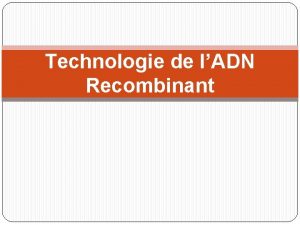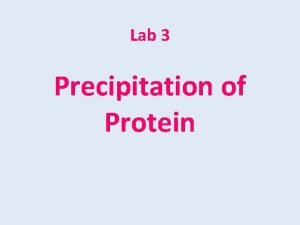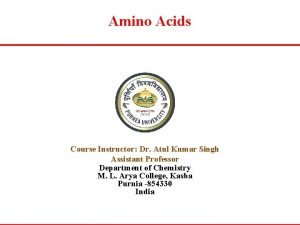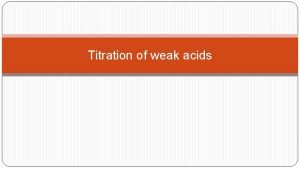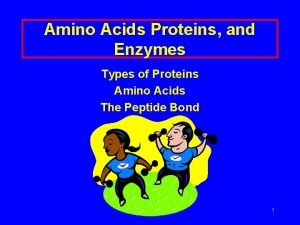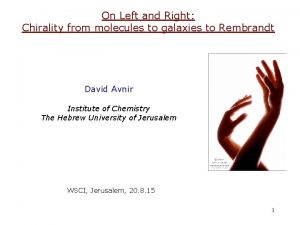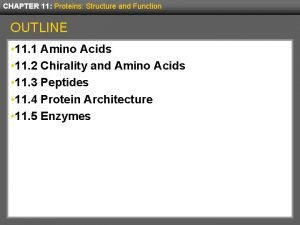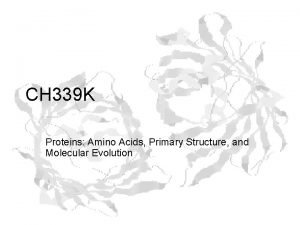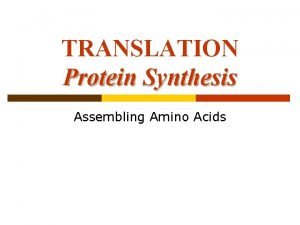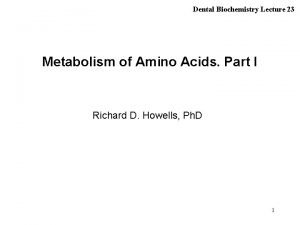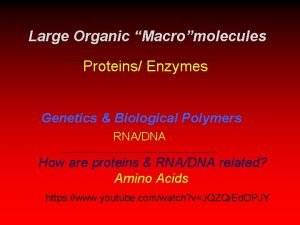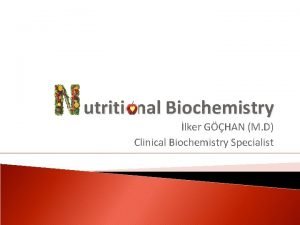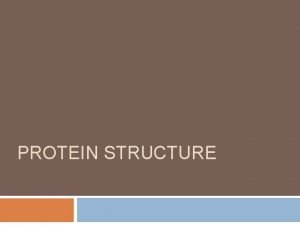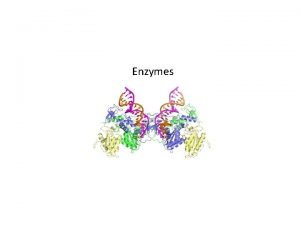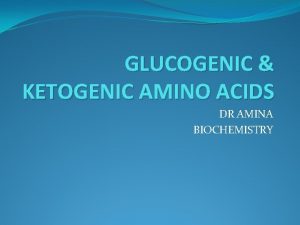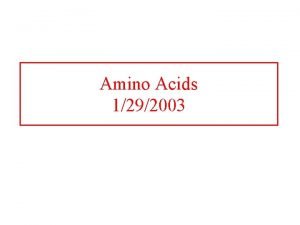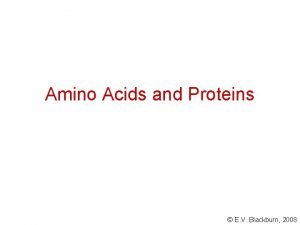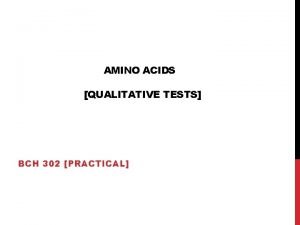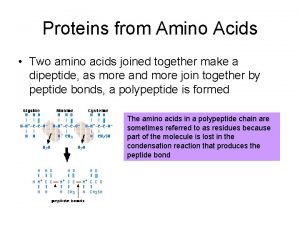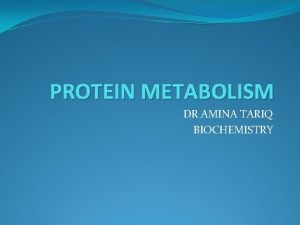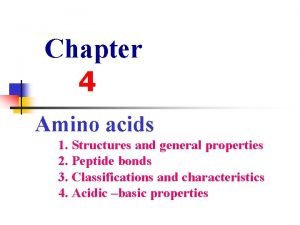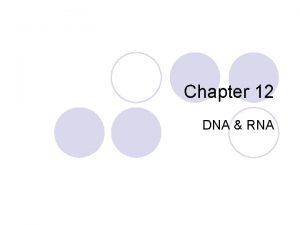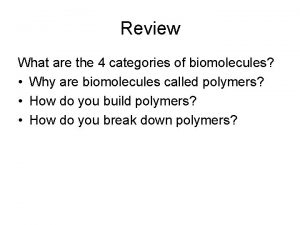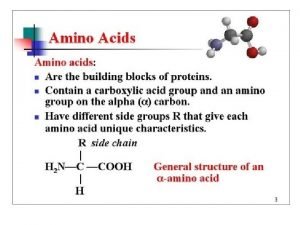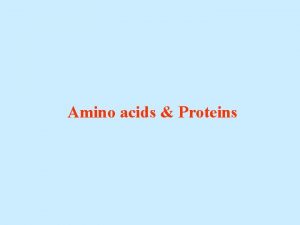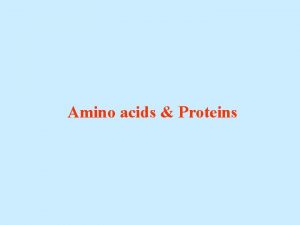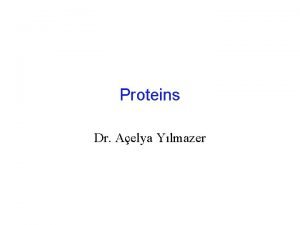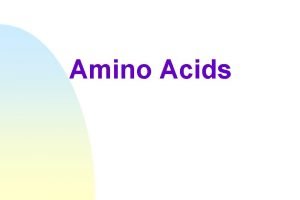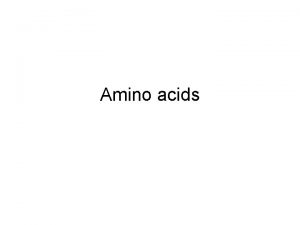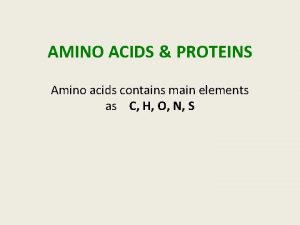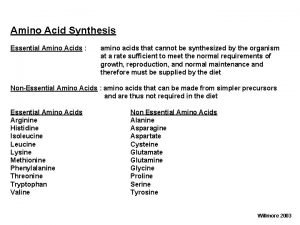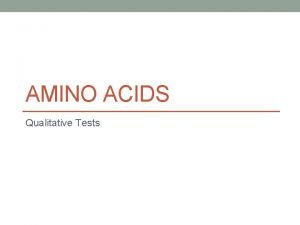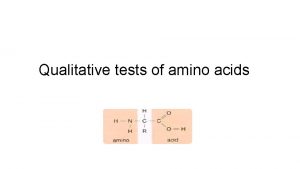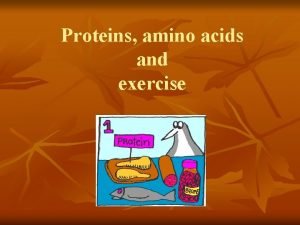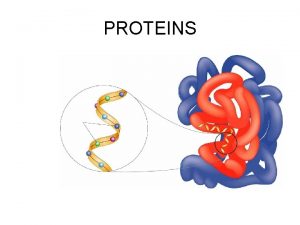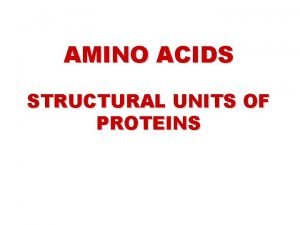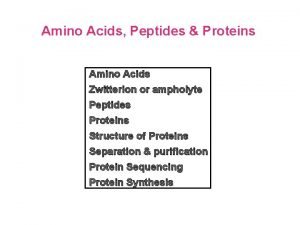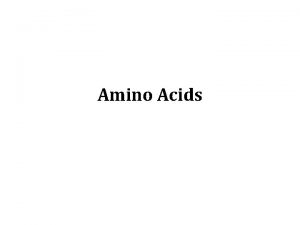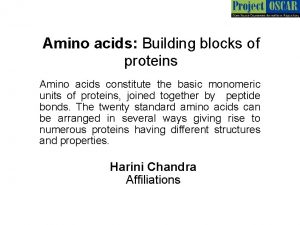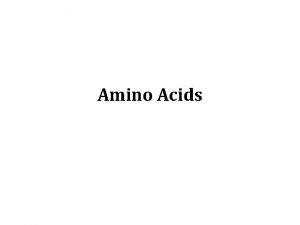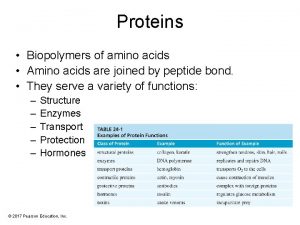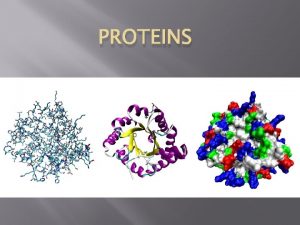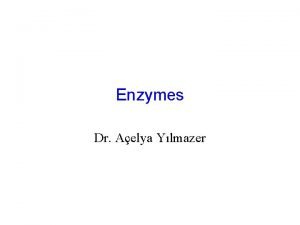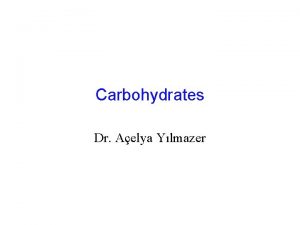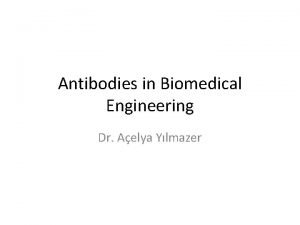Amino acids Dr Aelya Ylmazer Proteins Main Agents
























- Slides: 24

Amino acids Dr. Açelya Yılmazer

Proteins: Main Agents of Biological Function • Catalysis: –enolase (in the glycolytic pathway) –DNA polymerase (in DNA replication) • Transport: –hemoglobin (transports O 2 in the blood) –lactose permease (transports lactose across the cell membrane) • Structure: –collagen (connective tissue) –keratin (hair, nails, feathers, horns) • Motion: –myosin (muscle tissue) –actin (muscle tissue, cell motility)

Amino Acids: Building Blocks of Protein • Proteins are heteropolymers of -amino acids • Amino acids have properties that are well suited to carry out a variety of biological functions: – – Capacity to polymerize Useful acid-base properties Varied physical properties Varied chemical functionality

Amino Acids: Atom Naming • Organic nomenclature: start from one end • Biochemical designation: start from -carbon and go down the R-group

Most -Amino Acids are Chiral • The -carbon has always four substituents and is tetrahedral • All (except proline) have an acidic carboxyl group, a basic amino group, and an alpha hydrogen connected to the -carbon • Each amino acid has an unique fourth substituent R • In glycine, the fourth substituent is also hydrogen

Amino Acids: Classification Common amino acids can be placed in five basic groups depending on their R substituents: • Nonpolar, aliphatic (7) • Aromatic (3) • Polar, uncharged (5) • Positively charged (3) • Negatively charged (2)

Nonpolar, Aliphatic R Groups These amino acid side chains are hydrophobic

Aromatic R Groups These amino acid side chains absorb UV light at 270 -280 nm

Polar, Uncharged R Groups These amino acids side chains can form hydrogen bonding Cysteine can form disulfide bonds

Positively Charged (Basic) R Groups

Negatively Charged (Acidic) R Groups

Uncommon Amino Acids in Proteins Not incorporated by ribosomes Arise by post-translational modifications of proteins Reversible modifications, esp. phosphorylation is important in regulation and signaling

Ionization of Amino Acids At acidic p. H, the carboxyl group is protonated and the amino acid is in the cationic form At neutral p. H, the carboxyl group is deprotonated but the amino group is protonated. The net charge is zero; such ions are called Zwitterions At alkaline p. H, the amino group is neutral –NH 2 and the amino acid is in the anionic form.

Amino Acids Can Act as Buffers Amino acids with uncharged side-chains, such as glycine, have two p. Ka values: The p. Ka of the -carboxyl group is 2. 34 The p. Ka of the -amino group is 9. 6 It can act as a buffer in two p. H regimes.

Amino Acids Carry a Net Charge of Zero at a Specific p. H • Zwitterions predominate at p. H values between the p. Ka values of amino and carboxyl group • For amino acid without ionizable side chains, the Isoelectric Point (equivalence point, p. I) is • At this point, the net charge is zero – AA is least soluble in water – AA does not migrate in electric field

Ionizable Side Chains Can Show Up in Titration Curves • Ionizable side chains can be also titrated • Titration curves are now more complex • p. Ka values are discernable if two p. Ka values are more than two p. H units apart

How to Calculate the p. I When the Side-chain is Ionizable? • Identify species that carries a net zero charge • Identify p. Ka value that defines the acid strength of this zwitterion: (p. K 2) • Identify p. Ka value that defines the base strenght of this zwitterion: (p. KR) • Take the average of these two p. Ka values

Formation of Peptides are small condensation products of amino acids They are “small” compared to proteins (Mw < 10 k. Da)

Peptide Ends are Not the Same AA 1 AA 2 AA 3 AA 4 Numbering starts from the amino terminus AA 5

The Three Letter Code • Naming starts from the N-terminus • Sequence is written as: Ala-Glu-Gly-Lys • Sometimes the one-letter code is used: AEGK

Peptides: A Variety of Functions • Hormones and pheromones: – insulin (think sugar) – oxytocin (think childbirth) – sex-peptide (think fruit fly mating) • Neuropeptides – substance P (pain mediator) • Antibiotics: – polymyxin B (for Gram - bacteria) – bacitracin (for Gram + bacteria) • Protection, e. g. toxins – amanitin (mushrooms) – conotoxin (cone snails) – chlorotoxin (scorpions)

Proteins are: • Polypeptides (covalently linked -amino acids) + possibly – • cofactors, • coenzymes, • prosthetic groups, • other modifications • Cofactor is a general term for functional non-amino acid component – Metal ions or organic molecules • Coenzyme is used to designate an organic cofactors – NAD+ in lactate dehydrogenase • Prosthetic groups are covalently attached cofactors – Heme in myoglobin

Polypeptide Size in Some Proteins

Classes of Conjugated Proteins
 Amino acids are joined together in proteins by
Amino acids are joined together in proteins by Enes ylmazer
Enes ylmazer Precipitation of proteins by strong mineral acids
Precipitation of proteins by strong mineral acids Conditionally essential amino acids
Conditionally essential amino acids Titration curve of valine
Titration curve of valine Properties of amino acids
Properties of amino acids Right handed amino acids
Right handed amino acids Salt bridge amino acids
Salt bridge amino acids Which amino acids have ionizable side chains
Which amino acids have ionizable side chains Amino acid structure
Amino acid structure Pvt tim hall
Pvt tim hall 20 amino acids structures
20 amino acids structures Nitrogen removal from amino acids
Nitrogen removal from amino acids Protein structure
Protein structure What are enzymes made of
What are enzymes made of Ketogenic amino acid
Ketogenic amino acid Milady perm steps
Milady perm steps Amino acids are building blocks of
Amino acids are building blocks of Acid base properties of amino acids
Acid base properties of amino acids Phenol containing amino acids
Phenol containing amino acids The chain of amino acids forms a
The chain of amino acids forms a Transdeamination of amino acids
Transdeamination of amino acids Properties of amino acids
Properties of amino acids Chapter 12 dna and rna
Chapter 12 dna and rna Francis crick
Francis crick

